Animal attachment Study guides, Revision notes & Summaries
Looking for the best study guides, study notes and summaries about Animal attachment? On this page you'll find 1037 study documents about Animal attachment.
Page 3 out of 1.037 results
Sort by

-
BIO 390 Exam 2 Questions With 100% Correct Answers
- Exam (elaborations) • 31 pages • 2024
-
- £11.72
- + learn more
BIO 390 Exam 2 Questions With 100% Correct Answers Virus - answerLatin for poison (Pasteur) Not living Not cellular Obligate intracellular parasite - answerPerform no metabolism Can not freely reproduce No protein synthesis Carry no or few enzymes Naked virus (non-enveloped virus) anatomy: - answerGenetic material (DNA or RNA) Capsid-protein coating (composed of capsomere proteins) Enveloped virus anatomy: - answerGenetic material (DNA or RNA) Capsid Envelope - phospholipid bilayer ...

-
Microbiology Chapter 13 Exam Questions with 100% Correct Answers | Verified | Updated
- Exam (elaborations) • 16 pages • 2024
- Available in package deal
-
- £10.10
- + learn more
Microbiology Chapter 13 Exam Questions with 100% Correct Answers | Verified | Updated 1) How do all viruses differ from bacteria? A) Viruses are filterable. B) Viruses are obligate intracellular parasites. C) Viruses do not have any nucleic acid. D) Viruses are not composed of cells. E) Viruses do not reproduce. - answerD 2) Which of the following statements provides the most significant support for the idea that viruses are nonliving chemicals? A) They are not composed of cells. B) ...
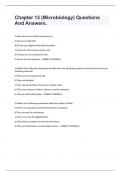
-
Chapter 13 (Microbiology) Questions And Answers.
- Exam (elaborations) • 17 pages • 2024
- Available in package deal
-
- £9.70
- + learn more
Chapter 13 (Microbiology) Questions And Answers. 1) How do all viruses differ from bacteria? A) Viruses are filterable. B) Viruses are obligate intracellular parasites. C) Viruses do not have any nucleic acid. D) Viruses are not composed of cells. E) Viruses do not reproduce. - CORRECT ANSWER D 2) Which of the following statements provides the most significant support for the idea that viruses are nonliving chemicals? A) They are not composed of cells. B) They are filterable. C) ...
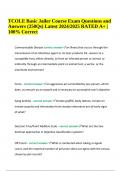
-
TCOLE Basic Jailer Course Final Exam Questions and Answers Latest 2024/2025 | 100% Correct
- Exam (elaborations) • 52 pages • 2024
- Available in package deal
-
- £12.93
- + learn more
TCOLE Basic Jailer Course Exam Questions and Answers Latest 2024/2025 | 100% Correct. Communicable Disease correct answer an illness that occurs through the transmission of an infectious agent or its toxic products frk. resivior to a susceptible host, either directly, as from an infected person or animal, or indirectly through an intermediate plant or animal host, a vector, or the inanimate environment Force - correct answer an aggressive act committed by any person, which does. ot amount ...

-
outline and evaluate animal studies of attachment ao1
- Exam (elaborations) • 6 pages • 2024
-
- £8.08
- + learn more
attachment 16 mark essay plans with Complete Solution outline and evaluate animal studies of attachment ao1 - ethological explanation seeks to understand the innate behaviour of animals by studying them in their natural environment, humans => animals Lorenz (1935) split clutch of gosling eggs into two, 1 with natural mother and 1 who saw him the first time they hatched- they then followed him and didn't recognise natural mother showing imprinting takes place within a critical period and...
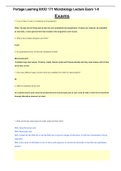
-
Portage Learning BIOD 171 Microbiology Lecture Exam 1-6 (100% CORRECT ANSWERS)
- Exam (elaborations) • 28 pages • 2022
-
- £8.89
- 2x sold
- + learn more
Exams 1. What are the two major types of nucleic acids and their roles? DNA- deoxyribonucleic acid RNA- Ribonucleic acid DNA- Cellular life has DNA and a role that DNA has is long-term s torage of information, it holds the characteristics of living organisms. RNA- Is the carrier of information in form of amino acid sequence. It converts the information in the DNA and synthesizes proteins True or False: Archaea is noted for its ability to survive under harsh conditions. True. Archaea can often be...
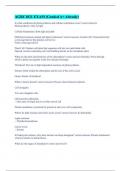
-
AGRC1021
- Exam (elaborations) • 21 pages • 2023
- Available in package deal
-
- £10.10
- + learn more
In what conditions do photosynthesis and cellular respiration occur? correct answers Photosynthesis: Only in light Cellular Respiration: Both light and dark Difference between animal and plant cytokinesis? correct answers Animal Cell: Characterized by a cleavage furrow that pinches cell in two Form a cleavage furrow Plant Cell: Produce cell plate that separates cell into two individual cells Deposit vesicles containing cell wall building blocks on the metaphase plate What are the p...
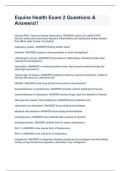
-
Equine Lameness and Diseases Quiz 2 Correct Questions & Answers!
- Exam (elaborations) • 6 pages • 2024
- Available in package deal
-
- £9.70
- + learn more
Dorsal -ANSWER relating to the upper side, or back of an animal Ventral -ANSWER relating to the underside of an animal Cranial -ANSWER anterior; relating to the skull or cranium Caudal -ANSWER posterior; of or like a tail Proximal -ANSWER closer to the origin of the body part or the point of attachment of a limb to the body trunk Distal -ANSWER farther from the origin of a body part or the point of attachment of a limb to the body trunk Muscular System -ANSWER made up of cardia...

-
Portage Learning BIOD 171 Module 6 Study guide with Complete Solutions rated A+
- Exam (elaborations) • 12 pages • 2024
- Available in package deal
-
- £8.08
- + learn more
Portage Learning BIOD 171 Module 6 Study guide with Complete Solutions rated A+ True or False: viruses can be classified as prokaryotic or eukaryotic - False. Viruses are neither prokaryotic or eukaryotic What is an obligate intracellular parasite? - viruses cannot replicate unless inside a living host cell. As a parasite, a virus depends on its living host to provide the framework (proteins, etc) to replicate—to make additional copies of itself. What is a viral capsid? - a membrane-like pr...

-
Portage Microbiology Exam #6 |Questions with 100% Correct Answers | Updated & Verified | 2024
- Exam (elaborations) • 7 pages • 2024
-
- £6.87
- + learn more
True or False: Because the genome is contained within an enclosed space, (much like the nucleus of a cell) viruses are classified as eukaryotic - False. Viruses are neither eukaryotic nor prokaryotic Describe the two basic components of a virus (short answer) - A virus has 1. genomic material comprised of either DNA or RNA and 2. a capsid, a membrane-like protective structure that contains the genetic material, similar to the nucleus of a eukaryotic cell The _____ surrounds the capsid of so...

£5.50 for your revision notes multiplied by 100 fellow students... Do the math: that's a lot of money! Don't be a thief of your own wallet and start uploading yours now. Discover all about earning on Stuvia


